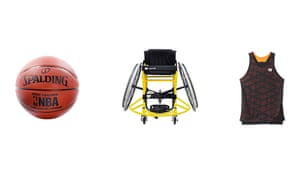I have always loved basketball. I grew up in the 90s (the Michael Jordan era) and would set my VCR to record NBA coverage on at stupid o’clock. I played a bit in school, just playground stuff, but with my prosthetic leg (I was born with my right leg missing from the hip), I couldn’t keep up. I found out about wheelchair basketball only by chance, when somebody at my hospital put me in touch with a local club. It’s liberating to play a sport controlled by your hands, not your feet.
Wheelchair basketball is the same as the running game in almost every way: the rules, the court size, the height of the basket. You can hold the ball in your lap, but every two pushes of the wheels you have to bounce, pass or shoot. People imagine these big, cumbersome chairs, but the game is extremely fast-paced and skilful.
I’m a bit of a jack of all trades on court, owing to my classification, which is based on the severity of your disability. An able-bodied player would be a five; someone with a spinal breakage around the chest might be a one. I’m a 3.5, pretty much slap-bang in the middle. Each team’s on-court players can add up to 14, to keep the playing field level.
Upper body fitness is crucial, with good shoulder strength for pushing. It helps that I like to keep fit (I qualified as a personal trainer last year; most of my clients are able-bodied). As a wheelchair athlete you can compete at a high level into your late 40s; I’m going to play for as long as my body lets me, just for the love of the game.
The social aspect is great, too. There are people at my club, the London Titans, who might not get out and do social stuff day-to-day. At training, they can meet people like themselves – that’s really empowering. When you’re on court, getting into your zone, you forget any stresses or issues outside. In my chair, taking shots, I’m happy.
My weekend workout
Years playing? Seriously, for 10 years.
How often do you play? Training twice a week and league games twice a month.
Most points scored in one match? 26.
Proudest moment? Winning a prestigious European trophy, the André Vergauwen cup.
Five ways to get started
1 In the domestic British leagues, you don’t need a disability to play – an able-bodied player would simply be classed as a five-point player. It’s only when you get to international level that you need to have a lower -limb disability.
2 Regular players have bespoke chairs, but most clubs have spares for newcomers. You can even use your everyday wheelchair if you have one.
3 There are clubs in most cities and towns in the UK, plus development leagues for little ones and a women’s league (though many teams are mixed). Find your local club on the British Wheelchair Basketball website.
4 The most important skill to master is chair control. A lot of people jump in at first and start pushing around, then panic because they can’t stop. Before trying to bounce or pass the ball, practise turning, spinning and stopping.
5 The general rule for shooting is, if you’re right-handed and the basket is in front of you at 12 o’clock, turn your chair to 10 o’clock, keep your elbow close to your body and shoot, keeping a line from shoulder to elbow straight up to the basket.
Essential kit

• Do you have a passion for exercise? Send your story to [email protected]
Source: Read Full Article
